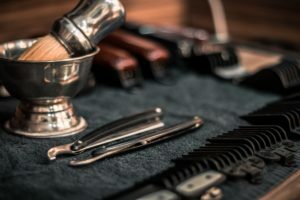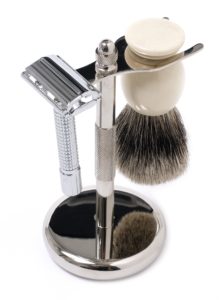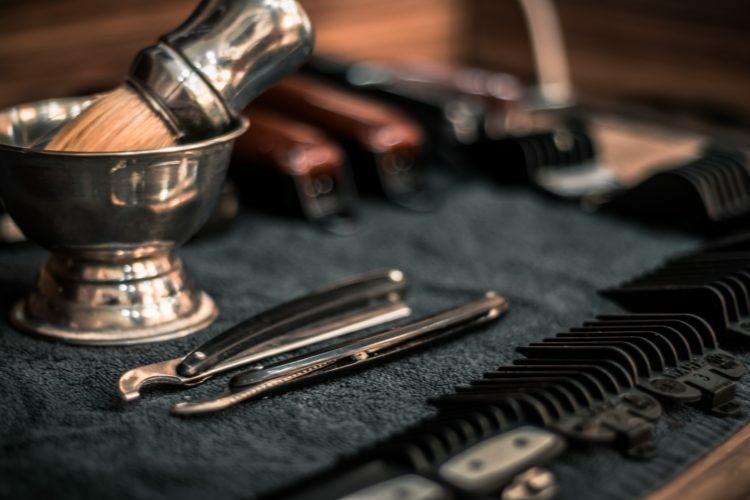By Bryan Ergle
Shaving… a task that young men often look forward to as a rite of passage, and then men and women both, for the most part, basically endure for the rest of their lives, the unavoidable consequence of having not been shipwrecked on a deserted island. But the way we shave today, the common place cartridge razors such as the Mach3 three-blade or Fusion 5-blade models, disposable variants thereof, or electric razors, are all ingrained in our grooming routines, but are actually relatively recent inventions. The first cartridge-type razor didn’t premier until 1970, with disposables coming on the market in the mid-1970’s from Bic. The three-bladed Mach3 didn’t premier until 1998.
Those may seem like a long time ago, but consider that those razors were preceded by the safety razor, which was patented in 1847, and the straight razor, which was first  made in a familiar-style model in the 1680’s. Earlier variants, accomplishing the same concept, in bronze, copper, and other metals, range back to more than 1500 BC. Suddenly 1970 doesn’t seem like so long ago!
made in a familiar-style model in the 1680’s. Earlier variants, accomplishing the same concept, in bronze, copper, and other metals, range back to more than 1500 BC. Suddenly 1970 doesn’t seem like so long ago!
Still, the modern cartridge, disposable, and electric razors have led many to frustration, and rightly so. Electric shavers do not give a close, smooth shave, no matter how high the quality (or cost), despite the convenience, and often leave whole hairs or patches of hair that have to be shaved with a traditional razor, or worse, plucked. For cartridge and disposables, the problem since the beginning has been that the race toward more blades have been many – that they have a fixed blade angle that you cannot adjust with the contour of your face (or legs or elsewhere), that the inner workings get clogged with hairs, and that the blades dull quickly and must be replaced.
This, too, on top of the cartridge razor’s race to add more blades. Starting with the Gillette Mach3 razor in 1998, followed by the Schick Quattro in 2003, companies have been caught up in the so-called ‘razor wars’ trying to add more blades. Indeed, this effort was lampooned by the satire site The Onion in 2004, in an article titled “Fuck Everything, We’re Doing Five Blades”. Little did they know that Gillette would release the Fusion, with five blades, in 2006. Now we even have six and seven blade razors.
Why is this a bad thing? If one blade is good, five must be that much better, right? Eh, not so fast. Your skin is sensitive to what it is exposed to – and how much. Consider this – if you were to rub a piece of sandpaper over your skin once, it would feel scratchy, a bit of nuisance. But start rubbing it repeatedly, and you’ll start to take the skin off. The same applies to blades. Each blade can irritate the skin, but probably not too bad – per blade. But now, every time you run that ‘blade’, meaning cartridge with five blades – over your skin, you’re actually drawing five blades across it. Put another way, one blade, five times. Every time, and with most cartridge razors, it takes more than one pass to get a good shave.
Where does this leave us? In an era of razor burn! And moreover, ingrown hairs, as each blade is designed to ‘dig’ deeper, pulling the hair to cut at or even below the root. Razor burn, ingrown hairs… both are a pain, and neither is a good look. But we are connoisseurs, and we want to do better than that. All this, to say nothing of the ridiculous, if you’ll permit me, cost of such razors and their cartridges, which have to replaced regularly. Last I checked – as I’m writing this article – the cartridges typically cost $3-$4 each.
This is not a radically new discovery that I’m telling you. Search for modern razors, and you will find several companies offering their futuristic solutions, carefully engineered to look like something out of science fiction, and often (of course!) only compatible with their own blades. But each of these solutions boils down to the same sort of concept, and I’m going to let you, connoisseur, in on the secret: these are variations on the basic safety razor that has been available since the 1850’s. Indeed, now even the straight razor is making a comeback!
I’ll also let you in on another secret – not about the new ‘solutions’, but rather, the safety razor – it works, and works very well. It also costs less, and gives better results. That’s the kind of combination I would want!
So, if these safety razors work so well, why don’t more people use them? There are a combination of reasons… first is convenience. Shaving with a safety razor, particularly at first, takes a little bit longer than a cartridge. As well, it takes a bit more effort to learn to do properly. Secondly, many people adopt the ‘next big thing’, just like people want the new model phone. Thirdly – marketing. Gillette was able to pour big money in advertising to convince people to adopt their new cartridge razors when they came out. Safety razors quickly become ‘grandpas technology’. Well, grandpa was right – as often happens.
First, let’s dispense with the ‘why’ I’m recommending this antiquated technology. A safety razor uses a single, double-sided disposable blade. It is typically made up of a short, metal handle, and a curved head that encloses most of the blade. While the safety razor has a single blade, it is double-sided, so you may flip it to get more shaving time between rinses. As well, the curved head allows for easy adjustment to meet the contours of your face, and the wide channel beneath the blade allows for easier cleaning… to say nothing of the fact that you can disassemble the razor, removing and cleaning the blade and other components.
Second, the single blade itself. Remember how every pass of the blade can increase skin irritation? Well, now it’s a single blade per pass over your skin. Even if you were to pass the blade over five times, you’d still only be equaling the blade contact of a single pass from a five-bladed cartridge razor, and you’d be allowing recovery time between each pass, along with more control at each step of the way. Third is a factor that only you can put a value on – image and experience. A safety razor on a stand next to a sink has a traditional, upscale feel that few, if any, cartridge razors will every convey, in my own opinion. Plus, shaving with a safety razor is more of an experience, part of our grooming rituals, rather than just a quick ‘scrape and run’.
 Next is cost. You know by now that we at Well Sewn are huge into making sure that you get the best return for your money. A safety razor itself costs roughly twice what a cartridge razor does – but it is a one-time investment. For example, a Mühle R89, a venerable standard safety razor, will cost you $38-$45 USD, or an Edwin Jagger DE89 runs around $28-$40. Personally, I have used a Jagger DE89 for years. Next, the big cost center for comparison – the blades.
Next is cost. You know by now that we at Well Sewn are huge into making sure that you get the best return for your money. A safety razor itself costs roughly twice what a cartridge razor does – but it is a one-time investment. For example, a Mühle R89, a venerable standard safety razor, will cost you $38-$45 USD, or an Edwin Jagger DE89 runs around $28-$40. Personally, I have used a Jagger DE89 for years. Next, the big cost center for comparison – the blades.
We’ve already discussed the cost of cartridges, so what about the double-edged razors that you use in a safety razor? There are many brands, and most all can be used in any safety razor, save maybe for the hyper-futuristic ones some companies are coming out with now. Names like Derby, Shark Astra, Feather, Lord, and Personna will become familiar to you, as you experiment and learn which brand and which blade suits you best, but the general rule I’ve found is this: blades can be used anywhere from 4-10 (or even more) times, depending on your preferences, and they sell for around $10-$12 for 100 blades. A single 100 pack, for $10, can stretch into two years, even if you shave daily. What’s better? They can be bought through places like Amazon with ease, no specialty stores required.
Finally, there is the issue of quality. A safety razor, while it takes a little time to learn and get used to, provides a cleaner, smoother shave, at least in my experience, and that of people I know who use them. I can’t recommend them enough. Ironically, the hardest thing to adjust to when learning to use a safety razor is unlearning the bad habits that come from shaving with cartridge razors, such as having to put a lot of pressure on the razor. It says a lot about the quality of the shave when a safety razor, by comparison, requires no pressure at all, literally just let it glide over the skin.
In future articles, we’ll be covering shaving creams, using brushes & bowls vs foams, after shave rituals, even ‘the immortal straight razor’. For now, though, my recommendation is simple, dear connoisseurs – ditch the cartridge razor and electric shavers, get yourself a safety razor, and learn how to use it – tutorials abound! You’ll save money, and no small amount of razor burn pain, in the long run. Oh, and parting thought – don’t start with a Feather blade. Trust me, you’re not there yet. Might I recommend a Derby Platinum?



